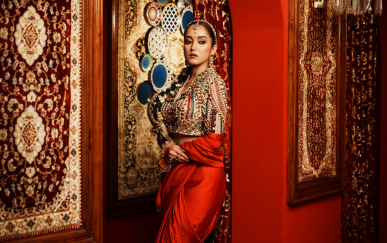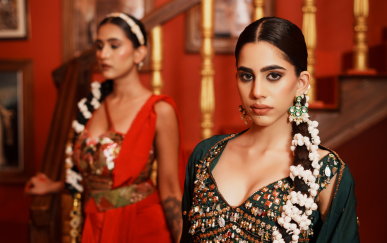Celebrating Traditions: The Story Behind Our Signature Embroidery Techniques
At House of Anmol Jain, the essence of our brand lies in the rich tapestry of Indian traditions,
meticulously woven into every garment through our signature embroidery techniques. Embroidery,
a craft that has been passed down through generations, is more than just an adornment for us—it is
a celebration of heritage, artistry, and culture. Join us as we delve into the story behind our
signature embroidery techniques and how they define the luxury and elegance of House of Anmol
Jain.
The Heritage of Indian Embroidery
India's diverse cultural landscape is reflected in its myriad embroidery styles, each region offering its
unique contribution to this intricate art form. From the royal courts of Mughal emperors to the
bustling bazaars of Rajasthan, embroidery has been an integral part of Indian textile history. At
House of Anmol Jain, we honor this heritage by incorporating traditional techniques into our
contemporary designs, creating pieces that are both timeless and innovative.
Zardozi: The Art of Royal Embellishment
One of our signature techniques is Zardozi, a form of metallic embroidery that originated in Persia
and flourished under the Mughal dynasty in India. Zardozi involves the use of gold and silver threads, often embellished with precious stones, pearls, and sequins. This technique is renowned for its opulence and intricacy, making it a favorite for bridal and ceremonial wear.
At House of Anmol Jain, our artisans masterfully execute Zardozi to create stunning patterns that exude regal elegance. Whether it’s the intricate floral motifs or the elaborate paisley designs, each piece is a testament to the unparalleled craftsmanship and attention to detail that defines our brand.
Chikankari: The Poetry of Threads
Chikankari, a delicate and refined form of embroidery from Lucknow, Uttar Pradesh, is another hallmark of our collections. Known for its intricate and subtle patterns, Chikankari involves the use of white thread on fine fabrics like muslin, silk, and cotton. This technique creates a shadow effect, giving the fabric a unique texture and depth.
We at House of Anmol Jain, elevate Chikankari by blending traditional patterns with modern silhouettes. Our designers often use pastel shades and luxurious fabrics to highlight the delicate beauty of Chikankari, resulting in garments that are both ethereal and elegant.
Gota Patti: The Glamour of Gold and Silver
Gota Patti is a traditional embroidery technique from Rajasthan that involves the appliqué of gold and silver ribbons onto fabric. This technique creates a shimmering effect, adding a touch of glamour to any outfit. Traditionally used in bridal wear and festive attire, Gota Patti is celebrated for its bold and vibrant aesthetic.
Our approach to Gota Patti at House of Anmol Jain is to fuse its traditional charm with contemporarydesigns. We use this technique to embellish sarees, lehengas, and anarkalis, creating pieces that are perfect for grand celebrations and weddings. The intricate patterns and gleaming accents of Gota Patti make our garments stand out, reflecting the joyous spirit of Indian festivities.
Kantha: The Art of Storytelling
Kantha, an embroidery technique from Bengal, is known for its simple, running stitches that create elaborate motifs and patterns. Originally used to upcycle old saris and dhotis, Kantha embroidery tells stories through its intricate designs, often depicting scenes from daily life, folklore, and nature.
At House of Anmol Jain, we embrace the narrative aspect of Kantha, incorporating its unique stitches into our collections. Our Kantha-embroidered pieces often feature motifs inspired by nature and mythology, adding a touch of whimsy and nostalgia to our modern creations. The versatility of Kantha allows us to experiment with different fabrics and colors, resulting in garments that are both traditional and contemporary.
Mirror Work: The Sparkle of Tradition
Mirror work, or shisha embroidery, is a technique that originated in Gujarat and Rajasthan. It involves attaching small mirrors to fabric using embroidery stitches, creating a sparkling effect that catches the light beautifully. Mirror work is often used in festive and bridal wear, adding a touch of glamour and vibrancy to the garments.
At House of Anmol Jain, we use mirror work to enhance the visual appeal of our designs. Our mirror- embellished pieces are perfect for special occasions, reflecting the joyous and celebratory nature of Indian culture. The combination of mirrors with colorful threads and intricate patterns creates a dazzling effect that is both traditional and contemporary.
Innovation and Tradition: A Perfect Blend
While we are deeply rooted in tradition, we also believe in the importance of innovation. At House of Anmol Jain, our designers continuously explore new ways to blend traditional techniques with modern aesthetics. This fusion allows us to create garments that are unique, elegant, and relevant to today's fashion landscape.
Our commitment to quality and craftsmanship is evident in every piece we create. Each garment undergoes a rigorous process of design, embroidery, and finishing, ensuring that it meets the highest standards of luxury and elegance. Our artisans, who have honed their skills over generations, bring a level of expertise and passion to their work that is truly unmatched.
Conclusion
At House of Anmol Jain, our signature embroidery techniques are a celebration of Indian heritage and craftsmanship. Each stitch tells a story, each motif reflects a tradition, and each garment embodies the timeless elegance that defines our brand. We invite you to explore the world of House of Anmol Jain, where tradition meets innovation, and every piece is a work of art.
Through our commitment to preserving and elevating traditional embroidery techniques, we continue to create garments that honor the past while embracing the future. Join us in celebrating the rich tapestry of Indian culture, one stitch at a time.
meticulously woven into every garment through our signature embroidery techniques. Embroidery,
a craft that has been passed down through generations, is more than just an adornment for us—it is
a celebration of heritage, artistry, and culture. Join us as we delve into the story behind our
signature embroidery techniques and how they define the luxury and elegance of House of Anmol
Jain.
The Heritage of Indian Embroidery
India's diverse cultural landscape is reflected in its myriad embroidery styles, each region offering its
unique contribution to this intricate art form. From the royal courts of Mughal emperors to the
bustling bazaars of Rajasthan, embroidery has been an integral part of Indian textile history. At
House of Anmol Jain, we honor this heritage by incorporating traditional techniques into our
contemporary designs, creating pieces that are both timeless and innovative.
Zardozi: The Art of Royal Embellishment
One of our signature techniques is Zardozi, a form of metallic embroidery that originated in Persia
and flourished under the Mughal dynasty in India. Zardozi involves the use of gold and silver threads, often embellished with precious stones, pearls, and sequins. This technique is renowned for its opulence and intricacy, making it a favorite for bridal and ceremonial wear.
At House of Anmol Jain, our artisans masterfully execute Zardozi to create stunning patterns that exude regal elegance. Whether it’s the intricate floral motifs or the elaborate paisley designs, each piece is a testament to the unparalleled craftsmanship and attention to detail that defines our brand.
Chikankari: The Poetry of Threads
Chikankari, a delicate and refined form of embroidery from Lucknow, Uttar Pradesh, is another hallmark of our collections. Known for its intricate and subtle patterns, Chikankari involves the use of white thread on fine fabrics like muslin, silk, and cotton. This technique creates a shadow effect, giving the fabric a unique texture and depth.
We at House of Anmol Jain, elevate Chikankari by blending traditional patterns with modern silhouettes. Our designers often use pastel shades and luxurious fabrics to highlight the delicate beauty of Chikankari, resulting in garments that are both ethereal and elegant.
Gota Patti: The Glamour of Gold and Silver
Gota Patti is a traditional embroidery technique from Rajasthan that involves the appliqué of gold and silver ribbons onto fabric. This technique creates a shimmering effect, adding a touch of glamour to any outfit. Traditionally used in bridal wear and festive attire, Gota Patti is celebrated for its bold and vibrant aesthetic.
Our approach to Gota Patti at House of Anmol Jain is to fuse its traditional charm with contemporarydesigns. We use this technique to embellish sarees, lehengas, and anarkalis, creating pieces that are perfect for grand celebrations and weddings. The intricate patterns and gleaming accents of Gota Patti make our garments stand out, reflecting the joyous spirit of Indian festivities.
Kantha: The Art of Storytelling
Kantha, an embroidery technique from Bengal, is known for its simple, running stitches that create elaborate motifs and patterns. Originally used to upcycle old saris and dhotis, Kantha embroidery tells stories through its intricate designs, often depicting scenes from daily life, folklore, and nature.
At House of Anmol Jain, we embrace the narrative aspect of Kantha, incorporating its unique stitches into our collections. Our Kantha-embroidered pieces often feature motifs inspired by nature and mythology, adding a touch of whimsy and nostalgia to our modern creations. The versatility of Kantha allows us to experiment with different fabrics and colors, resulting in garments that are both traditional and contemporary.
Mirror Work: The Sparkle of Tradition
Mirror work, or shisha embroidery, is a technique that originated in Gujarat and Rajasthan. It involves attaching small mirrors to fabric using embroidery stitches, creating a sparkling effect that catches the light beautifully. Mirror work is often used in festive and bridal wear, adding a touch of glamour and vibrancy to the garments.
At House of Anmol Jain, we use mirror work to enhance the visual appeal of our designs. Our mirror- embellished pieces are perfect for special occasions, reflecting the joyous and celebratory nature of Indian culture. The combination of mirrors with colorful threads and intricate patterns creates a dazzling effect that is both traditional and contemporary.
Innovation and Tradition: A Perfect Blend
While we are deeply rooted in tradition, we also believe in the importance of innovation. At House of Anmol Jain, our designers continuously explore new ways to blend traditional techniques with modern aesthetics. This fusion allows us to create garments that are unique, elegant, and relevant to today's fashion landscape.
Our commitment to quality and craftsmanship is evident in every piece we create. Each garment undergoes a rigorous process of design, embroidery, and finishing, ensuring that it meets the highest standards of luxury and elegance. Our artisans, who have honed their skills over generations, bring a level of expertise and passion to their work that is truly unmatched.
Conclusion
At House of Anmol Jain, our signature embroidery techniques are a celebration of Indian heritage and craftsmanship. Each stitch tells a story, each motif reflects a tradition, and each garment embodies the timeless elegance that defines our brand. We invite you to explore the world of House of Anmol Jain, where tradition meets innovation, and every piece is a work of art.
Through our commitment to preserving and elevating traditional embroidery techniques, we continue to create garments that honor the past while embracing the future. Join us in celebrating the rich tapestry of Indian culture, one stitch at a time.









